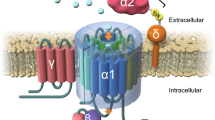Abstract
A 68-year-old woman with ovarian cancer suffered a loss of visual acuity and color perception after inadvertent overdosage with the antineoplastic agent cisplatin. Her acuity returned to normal but a tritan color defect persisted more than a year later. Her electroretinogram was stable between 7 weeks and 15 months after cisplatin administration, with a negative-type scotopic response, but also reduced cone b waves and a loss of some scotopic oscillatory potentials. With light stimuli between 10 and 100 ms in duration, the photopic on-responses were markedly reduced while the off-responses were normal or close to it. This case suggests that cisplatin may selectively injure on-pathways in the retina and indicates the need to expand the list of disorders that may cause a negative-type electroretinogram.
Similar content being viewed by others
Abbreviations
- CSNB:
-
congenital stationary night blindness
References
Schubert G, Bornschein H. Beitrag zur Analyse des menschlichen Elektroretinogramms. Ophthalmologica 1952; 123: 396–413.
Carr RE. Congenital stationary nightblindness. Trans Am Ophthalmol Soc 1974; 72: 448–87.
Miyake Y, Yagasaki K, Horiguchi M, Kawase Y, Kanda T. Congenital stationary night blindness with negative electroretinogram. Arch Ophthalmol 1986; 104: 1013–20.
Ripps H, Carr RE, Siegel IM, Greenstein VC. Functional abnormalities in vincristineinduced night blindness. Invest Ophthalmol Vis Sci 1984; 25: 787–94.
Berson EL, Lessell S. Paraneoplastic night blindness with malignant melanoma. Am J Ophthalmol 1988; 106: 307–11.
Alexander KR, Fishman GA, Peachey NS, Marchese AL, Tso MOM. ‘On’ response defect in paraneoplastic night blindness with cutaneous malignant melanoma. Invest Ophthalmol Vis Sci 1992; 33: 477–83.
Miyake Y, Yagasaki K, Horiguchi M, Kawase Y. On- and off-responses in photopic electroretinogram in complete and incomplete types of congenital stationary night blindness. Jpn J Ophthalmol 1987; 31: 81–7.
Houchin KW, Purple RL, Wirtschafter JD. X-linked congenital stationary night blindness and depolarizing bipolar system dysfunction. Invest Ophthalmol Vis Sci 1991; 32(suppl.): 1229.
Young RSL. Low-frequency component of the photopic ERG in patients with X-linked congenital stationary night blindness. Clin Vision Sci 1991; 6: 309–15.
Marmor MF, Arden GB, Nilsson SE, Zrenner E. Standard for clinical electroretinography. Arch Ophthalmol 1989; 107: 816–9. Reprinted with permission in Doc Ophthalmol 1989; 73(4): 303–11.
Daw NW, Jensen RJ, Brunken WJ. Rod pathways in mammalian retinae. Trends Neurosci 1990; 13: 110–5.
Ripps H. Night blindness revisited. From man to molecules. Invest Ophthalmol Vis Sci 1982; 23: 588–609.
Krill AE, Martin D. Photopic abnormalities in congenital stationary nightblindness. Invest Ophthalmol 1971; 10: 625–36.
Ripps H, Mehaffey L III, Siegel IM, Niemeyer G. Vincristine-induced changes in the retina of the isolated arterially-perfused cat eye. Exp Eye Res 1989; 48: 771–90.
Lachapelle P, Little JM, Polomeno RC. The photopic electroretinogram in congenital stationary night blindness with myopia. Invest Ophthalmol Vis Sci 1983; 24: 442–50.
Wilding G, Caruso R, Lawrence TS, Ostchega Y, Ballintine EJ, Young RC, Ozols RF. Retinal toxicity after high-dose cisplatin therapy. J Clin Oncol 1985; 3: 1683–9.
Miller DF, Bay JW, Lederman RJ, Purvis JD, Rogers LR, Tomsak RL. Ocular and orbital toxicity following intracarotid injection of BCNU (carmustine) and cisplatinum for malignant gliomas. Ophthalmology 1985; 92: 402–6.
Kupersmith MJ, Frohman LP, Choi IS, Foo SH, Hiesinger E, Berenstein A, Wise A, Carr RE, Ransohoff J. Visual system toxicity following intra-arterial chemotherapy. Neurology 1988; 38: 284–9.
Kupersmith MJ, Seiple WH, Holopigian K, Noble K, Hiesiger E, Warren F. Maculopathy caused by intra-arterially administered cisplatin and intravenously administered carmustine. Am J Ophthalmol 1992; 113: 435–8.
Greenberg D, Fishman G, Tripathi R, Tripathi B, Peyman GA. The effects of intravitreal cisplatinum. Invest Ophthalmol Vis Sci 1985; 26(suppl): 60.
Sawyer RA, Selhorst JB, Zimmerman LE, Hoyt WF. Blindness is caused by photoreceptor degeneration as a remote effect on cancer. Am J Ophthalmol 1976; 81: 606–13.
Keltner JL, Roth AM, Chang RS. Photoreceptor degeneration. Arch Ophthalmol 1983; 101: 564–9.
Perry MC, ed. The chemotheraphy source book. Baltimore: Williams & Wilkins, 1992.
Author information
Authors and Affiliations
Rights and permissions
About this article
Cite this article
Marmor, M.F. Negative-type electroretinogram from cisplatin toxicity. Doc Ophthalmol 84, 237–246 (1993). https://doi.org/10.1007/BF01203656
Accepted:
Issue Date:
DOI: https://doi.org/10.1007/BF01203656




